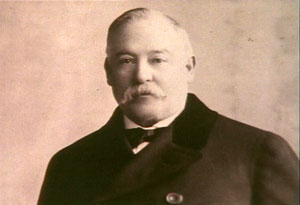Born in Ireland, Marcus Daly, the youngest of 11 children, came to America in 1856 at the age of 15 to escape the poverty of home. Working his way across the country he eventually landed in Virginia City, Nevada, where he gained valuable mining experience in the silver mine. There he met George Hearst (father of William Randolph Hearst) who would later become one of his financial backers. By 1871 he had moved to Utah and became involved with the Walker Brothers who were investing in mining and involved in banking. As their foreman, he was sent to Butte in 1876 to assess the Alice mine for the Walkers. When they bought it, he acquired a 1/5 interest.
He moved to Butte to manage the Alice and also sought out mining opportunities for himself. He acquired the Anaconda mine, which was initially worked as a silver mine, from Michael Hickey. After the discovery of one of the largest deposits of copper in the world some 300 feet down, Daly’s and Butte’s fortunes were forever changed due to the insatiable demand for electricity and, therefore, copper.
Daly needed money for a smelter, and he sought and obtained the financial backing of George Hearst, who by then was in partnership with James Ben Alli Haggin and Lloyd Tevis, a hugely successful mining and banking syndicate.
The site he chose for the smelter was 28 miles west of Butte, and there the town of Anaconda was born. The Washoe smelter opened in 1884 and soon produced about $17 million annually. Daly's influence was widespread; he owned coal mines and vast timberlands to power the mills and smelter as well as several banks and the Anaconda Standard newspaper. He carried ore on his own Butte, Anaconda and Pacific Railroad, and he owned the Butte City Water Company. He also had a 22,000 acre ranch in the Bitterroot with an accompanying stock farm and race horses including the famous “Tammany.”
His infamous rivalry with another copper king, William Andrews Clark, ran on for years. His political activities were aimed not at getting elected, but at manipulating those who would be, keeping Clark out of the political sphere, and supporting those candidates at the federal level who would give him free rein in cutting timber. He also tried unsuccessfully to get Anaconda named as the capital of Montana.
In 1882 he joined forces with A.B. Hammond and others to form the Montana Improvement Company to exploit the timber resources of western Montana. Out of this association, the Bonner Mill was built, under the leadership of Hammond. Initially the mill had large contracts to supply the mines in Butte with timbers that propped up the mine shafts. However by 1889, when Hammond refused to support Daly politically, Daly cancelled the contract. Within nine years Daly was trying to buy Hammond’s mill- which he finally succeeded in doing for $1.5 in August of 1898. It became part of the Anaconda Mining Company, initially known as its Lumber Division. Daly died in 1900, but The Anaconda Company and its influence lived on.
When he Daly died in 1900, the Butte Miner newspaper summed up his life:
Marcus Daly was a man to remember. He fought his way from dire poverty to fabulous riches. A true empire builder, he was a man of extreme. A friend to his friends, to his enemies remorseless and unforgiving. Daly, a father figure watched over his family, his friends and his employees with a heartfelt benevolence. lt must be noted that when he ran the Anaconda Mining Company, he treated his employees better than most corporations of the time. More than any other man he built the Montana mining industry, he was a true son of Ireland, which he never forgot and helped."

